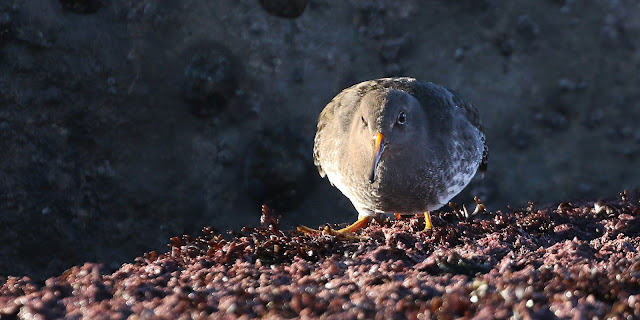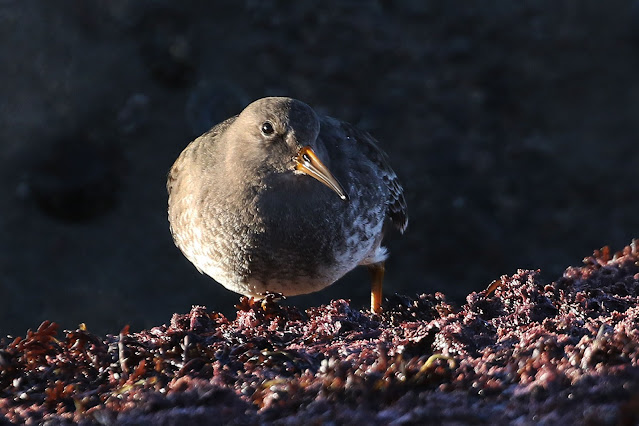Saturday was a complete right off with rain from dawn to dusk. I didn't even try to go out and decided it would be better to defer to the Sunday. The forecast was much better, and so it was in glorious sunshine I headed south to visit Southsea Castle first thing in the morning. Passing the exit for Farlington on the A27, the Peregrine was sitting at the top of the radio mast.
Every year we make this visit, last year due to the restrictions it was much later, but I would normally meet up with Ian early in the month to find the Purple Sandpiper that use the rocks around the castle as home during the winter. Timing is important though, high tide is not good, the birds are best seen while they are feeding on the exposed sea weed at low tide.
It is a short walk from the car park to the promenade, the number of people about was beginning to increase. It didn't take long to locate the Purple Sandpiper. They were feeding at the bottom of the ramp, keeping close to the sea and feeding amongst the sea weed that is probably submerged the longest. There were three feeding groups and a total of thirteen birds in all.

The birds are usually approachable and if you stay still they will come to you in the same way the Sanderling do. We wanted to be able to get down to almost eye level with, but the challenge would be getting down to them. My first attempt almost ended in disaster as I slipped on the rocks, but managed a controlled descent. Eventually we realised we would not be able to scramble down the ramp, it was too dangerous, so we walked back to the point where the promenade ramps up around the castle. From here we could walk back to the birds on relatively flat concrete, Adopting a crouched position, to improve the centre of gravity, we shuffled along the concrete, walking over the dangerous green ulva and slightly more confiding bladder wrack. Eventually we reached a position where we could watch the birds and allow them to come to us.
And come they did, at first over the rocks where the waves were crashing and sending spray up.
This one bird was preening in the morning sunshine.
It was then the sunshine that created some of the most atmospheric photographs I have taken of birds. The birds were feeding around the base of the rocks and shards of light would come through the gaps. While this had the potential to play havoc with the exposures as these grey birds were against a back ground of dark rocks and any light had the potential to wash out the photograph, it also provided a wonderful way to highlight the wader, if, you got the exposure right.
The Purple Sandpipers were not bothered by our presence and they eased their way towards us, probing and pushing the sea weed with a sewing machine like action of the bill.
These rocks are a regular winter location for the Purple Sandpipers, they arrive from somewhere in October and can be around until early April. The numbers vary, with counts of between 20 and 30 being reported in the past. Some days there may only be a few, but it seems that the normal number is around the thirteen we were seeing today. Others could easily be feeding out of view amongst the bigger rocks.
This image really highlights the morning light on the rocks, the purple of the sea weed and of course the Purple Sandpiper.
Purple sandpipers are hardy wading birds that breed on
coasts and tundra in the far north. It is slightly larger and stockier
than a dunlin, giving it a distinctive "dumpy" shape. In winter they
have a brown-grey head and back, with whitish underparts that have dark streaks
- giving them a less clean look than the similar dunlin. The short legs are
orange-yellow, and the down-curved bill has a yellowish base.
These birds forage on rocky coasts, picking up food by sight.
They mainly eat arthropods and molluscs,
also some plant material. One of the main staples are those of the Coelopa genera. These insects are known commonly as
"seaweed flies" because they feed, mate, and create a habitat out of
beached seaweed which is common near the Purple Sandpiper's habitat
The birds were now walking past us meaning that they had the sun directly behind them giving a different aspect.
For me though the best scenes were where the bird was highlighted by the sunshine and the rest of its surrounding remained in shadow. This meant that the bird was highlighted against a very black background.
I would follow the birds as they fed and wait for them to move into the light and then shoot away.
Although some were always completely in the shade.
These final images are some of my favourites.
By now I was getting quite stiff, stooping low to photograph, I stood up and this didn't appear to upset the birds. I felt I had enough images (over 500 in fact!), so we decided to walk back to the promenade and check the grounds of the castle for sleeping foxes. However the number of persons preambling was much higher and the foxes were all probably hiding. The Carrion Crows though were taking every opportunity and showed no fear of the human life, sitting quite closely on the fence.
Close up you get the opportunity to observe the nictitating membrane on the Crow's eye. This is a transparent or translucent third eyelid
present in some animals that can be drawn across the eye for protection
and to moisten it while maintaining visibility.
Next stop was going to be on Hayling Island, but the amount of cars and people meant nowhere to park so we opted to drop into Warblington to get the New Year Cattle Egret tick. It wasn't much better along Church Lane with again many cars and people walking in the sunshine, there is a lot to be said about going out on a Saturday.
After managing to find a parking space we set off to check the surrounding fields. Anything white would grab our attention, but this only turned out to be Little Egrets and Gulls. Out in Langstone Harbour there were Brent, Wigeon, Teal and Shelduck, while the waders were represented by Grey Plover, Lapwing and Redshank.
We walked along the small lanes and added Stock Dove to the year list. A field along Pook Lane was covered in feeding Black-headed Gulls, but right at the back close to a few feeding cattle was a single Cattle Egret.
But as I tried to get to a gap in the hedge where I would be a little closer it flew off, circled the field and then headed away over the church towards Emsworth.
We continued our search around the fields but could only find more Little Egrets. Deciding to call it in we had some lunch. But as we were driving away I noticed two Cattle Egret in the field we had seen the other bird earlier. I pulled over and managed to navigate some sticky mud and get a couple of decent photos.
It was a morning dominated by the Purple Sandpiper. When Ian and I decided to defer our day out until the Sunday I messaged him to same we would get photographs of Purple Sandpipers in the early morning light. Well we definitely managed that and I have some of the best Purple Sandpiper images I have taken. In the same message I also said we would achieve something in the afternoon, whether or not that came true will have to wait for another post.













































No comments:
Post a Comment